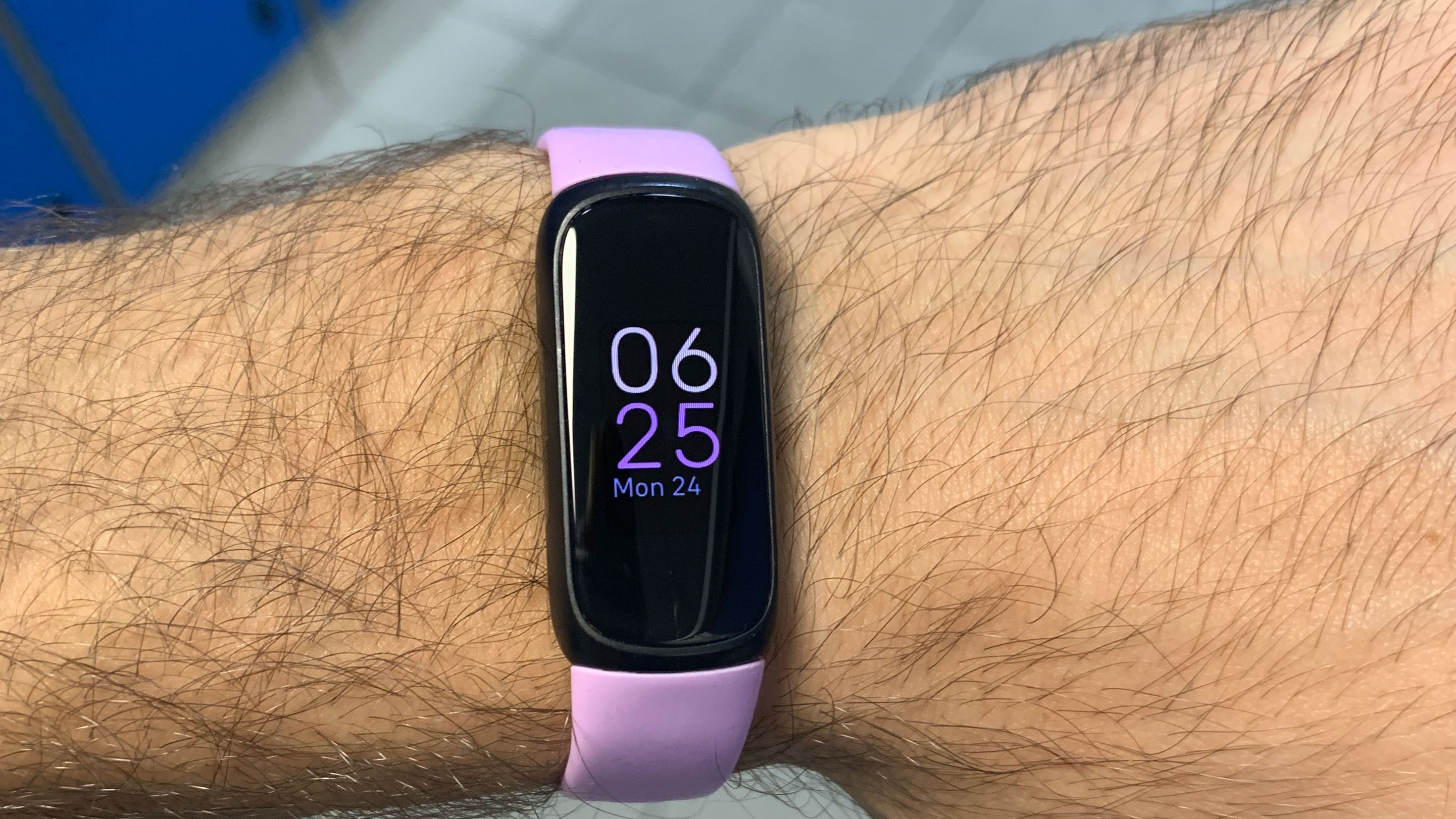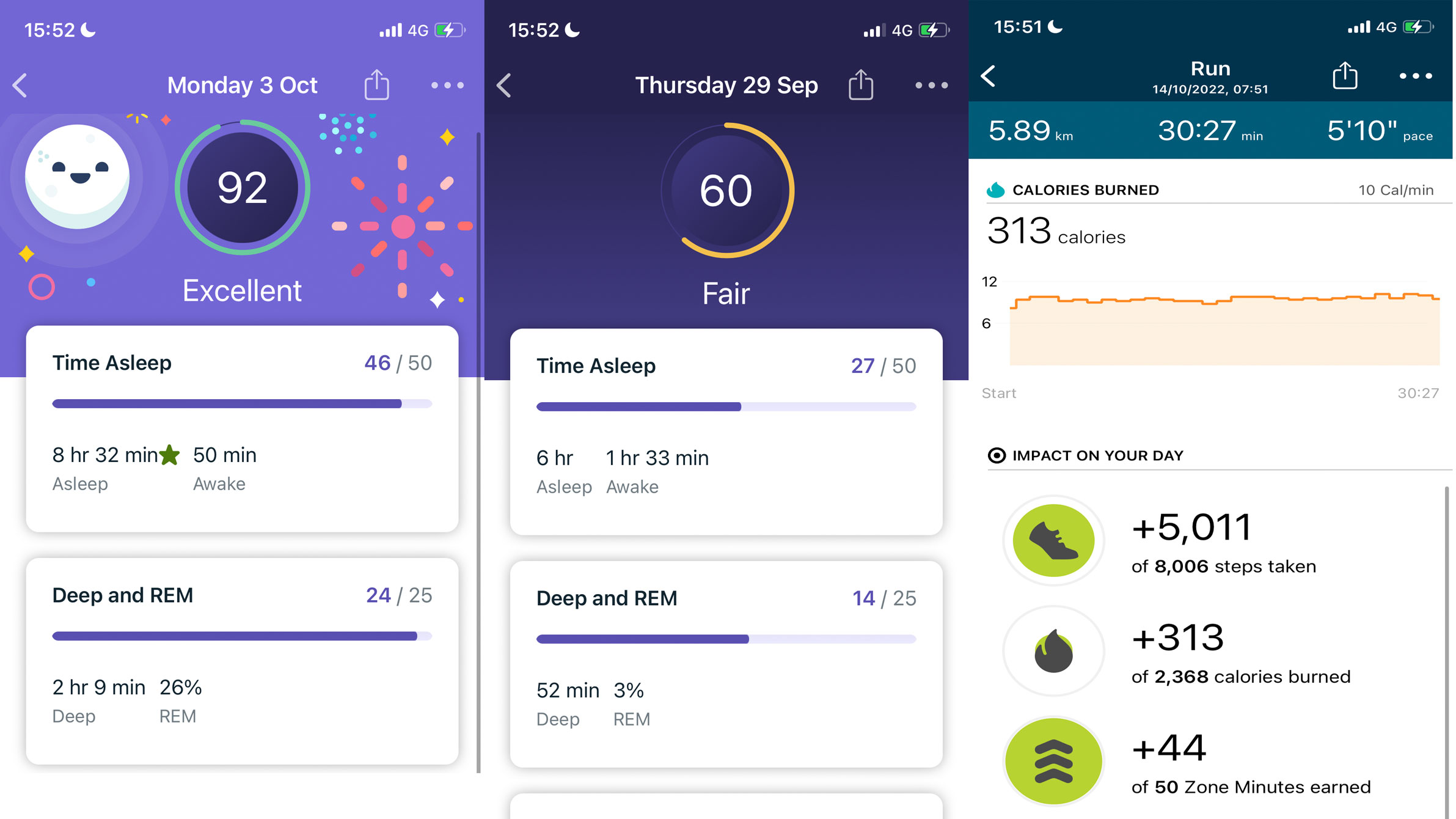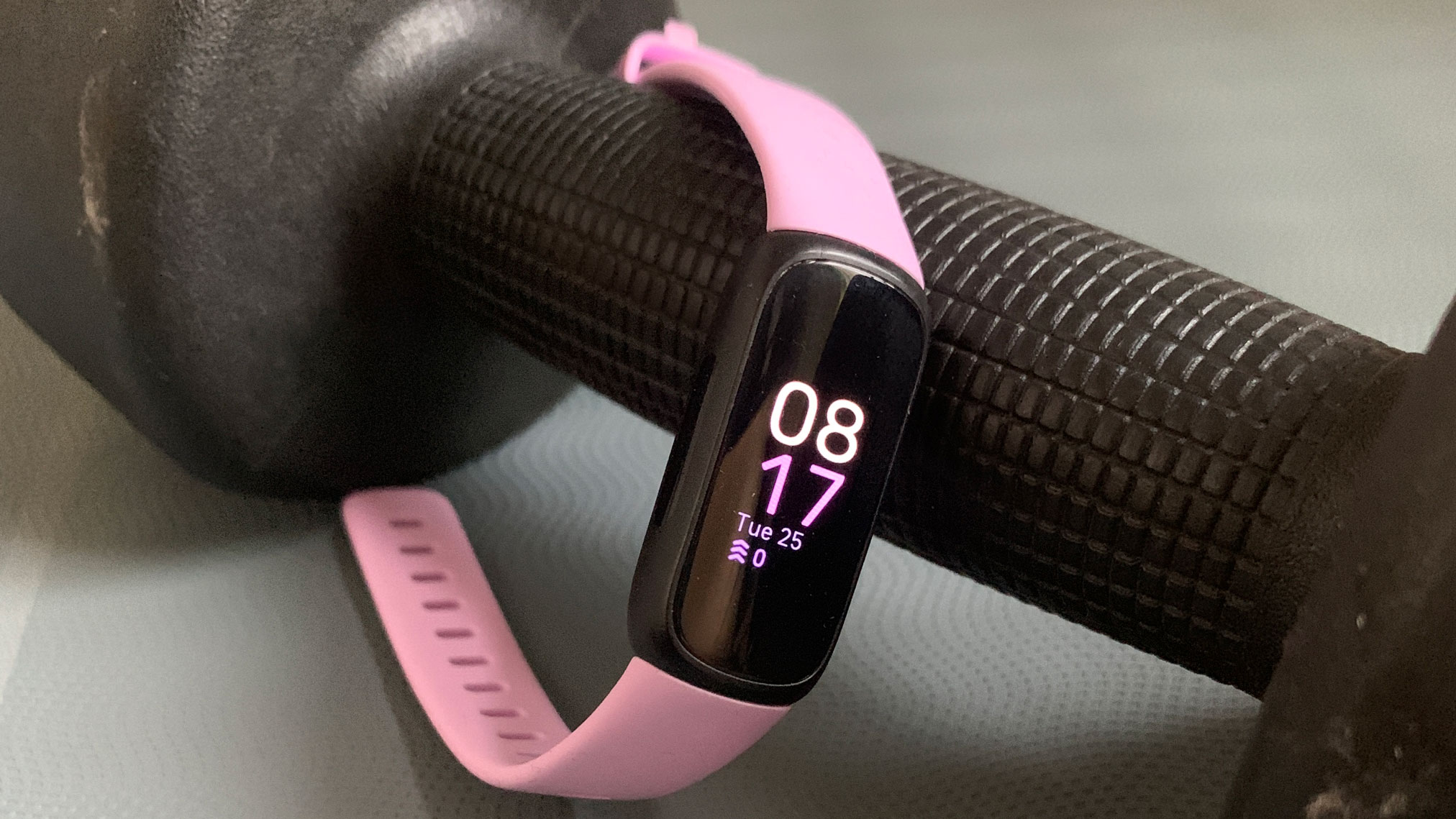Fitbit Inspire 3
Fitbit Inspire 3: One minute review
Alongside its brand-new smartwatches, the Fitbit Sense 2 and Fitbit Versa 4, Fitbit has launched an improved an improved version of its Inspire fitness tracker, the Inspire 3 which, if previous Inspire models are any guide, is set to take its place as one of the best fitness trackers.
The Fitbit Inspire 3 comes with a revamped design featuring a wider and longer main unit and a better-fitting silicone band. And while it features a color AMOLED display – a first for the Inspire range – it boasts the same impressive battery life battery life, even if you’re using the always-on display the tracker will last for around 10 days.
It also keeps all the features that made the Fitbit Inspire 2 a success. Like its predecessors, the Inspire 3 is easy to get used to and easy to use, and presents your health and fitness stats in a simple and useful manner.
It tracks your heart rate 24/7, and uses this information, combined with your sleep data, to provide an analysis of your Daily Readiness and Stress Management. It’ll also remind you to get up and walk around for a bit if you haven’t done so in a while, and if you’re having a stressful day you can also try and relax with the 2-minute guided breathing feature.
New to the Inspire 3 is Sp02 monitoring, which tracks oxygen levels in your blood and can alert you if your BO dips below a certain threshold, such as 90%, potentially a warning sign of hypoxia, and can aid in sleep and recovery tracking. Most full fitness smartwatches carry this sensor, so it's nice to see it make its way to the slender Inspire range at last.
Fitbit might not have revolutionized this device from a smart features point of view, but the new design and color display bring real improvements to the user experience.
Fitbit Inspire 3 review: Price and availability
Fitbit Inspire 3 is available to purchase now for $99.95 / £84.99 / AU$177. It comes with two bands and a charging cable in the box, as well as a six-month subscription to Fitbit Premium. The Inspire 2, on the other hand, used to have a one-year subscription, but the Inspire 3 has cut this in line with the rest of Fitbit's devices. If you're planning to continue using Premium, this is a real blow - you're $45/£40/AU$75 worse off than you would have been with the older tracker.
The Premium subscription gets you some extra features, including a Daily Readiness Score, a Sleep Profile, and lots of workouts to access through the Fitbit app.
The unit itself is only available in black, but you can choose between black, lilac, and morning glow for the band colors, which also come in two sizes: small and large.
Fitbit Inspire 3 review: Design and screen
- First Inspire model with a color display
- Sleek and lightweight design
- Scrolling is a little awkward sometimes
The design of the Fitbit Inspire 3 isn’t much different from the Inspire 2, with a slightly wider and longer main unit and a similarly shaped, although slightly redesigned, silicone band. It retains the sleek and light look and feel of its predecessor, and like that device it’s very comfortable on the wrist, and easy to use for most activities. The silicone grips your skin to just the right degree to avoid uncomfortable movements while exercising, although it might pull a few hairs if you fasten it quite tight – which is recommended for the most accurate heart rate readings.
The Fitbit Inspire 3 is the first Inspire to get a color display, and it’s an impressive addition considering that it in our testing it didn't appear to affect the battery life. The display is very bright, and features an always-on display mode that lets you check the time and your step count without waking the device.
Its lightweight and small size also make for seamless integration with your exercise and day-to-day routines. I found that, for example, while swimming, it almost felt like I wasn’t wearing a watch at all compared to when I wore my Garmin. This is a big plus for a wearable, especially for those who aren’t used to wearing a tracking device while exercising – and particularly in the pool, where some might feel a little intimidated going in with a watch for the first time.
The main unit is slightly wider than the Inspire 2, but that makes no difference to its lightweight nature - the Inspire 2 weighs 8g while Inspire 3 is 17g, which is still ridiculously light. Some will probably still find that it’s a little small for scrolling through the various options or reading post-exercise data, although you can of course also see your data in the Fitbit app on your phone, where everything is laid out clearly and intuitively.
As on the Inspire 2, two haptic buttons on each side of the main unit can be used to wake the device and bring up the home screen with the time. This is very handy, because unless you have the ‘auto wake’ option turned on the Fitbit’s display won’t wake automatically when you raise your wrist (to avoid interrupting your sleep during the night with its high brightness).
- Design score: 4/5

Fitbit Inspire 3 review: Features
- Few new features compared to the Inspire 2
- There’s a new SpO2 sensor to monitor oxygen in the blood
- Sleep tracking de-stigmatizes not getting your eight hours every night
The Fitbit Inspire 3 comes with a comprehensive portfolio of health-tracking features for the price, and new to the Inspire 3 is SpO2 monitoring, which measures the quantity of oxygen in your blood. While athletes and fitness enthusiasts have been using SpO2 readings as a measure of BO dips, potentially a warning sign of hypoxia, and aiding in sleep and recovery tracking. for a few years now, this particular health metric became more widely known during the Covid-19 pandemic, as it was a key indicator of how well a patient was recovering from the illness.
The Inspire 3’s heart rate monitoring 24/7 proved reasonably accurate in our testing, and this data feeds into lots of other features of the device, such as calorie count and exercise zones (cardio and fat-burning, for example). In April 2022 Fitbit added irregular heart rhythm notifications to the Inspire 2, and the Inspire 3 also has this potentially life-saving feature.
It also offers Fitbit’s full suite of useful, and easy to use, sleep- and stress-tracking features. You’ll need a Fitbit Premium subscription to take full advantage of the Sleep Profile data and Daily Readiness scores, but were definitely the data I took the most advantage of and offered genuinely valuable insights into my wellbeing.
The sleep tracker breaks down your night’s sleep into awake time, REM, light, and deep sleep, and gives you a Sleep Score based on how much time you spent in each of these sleep phases.
As someone who struggles with sleep anxiety, I found the data especially useful, and a reassuring counter to the orthodoxy that anything less than eight hours sleep isn’t enough. For example, my sleep times during my testing period were always around six hours a night, which conventional wisdom would suggest is not enough. However, my average Sleep Score in the Fitbit app was always around 70/100, and tagged as ‘Fair’.
I think this is a clever way to look at sleep, as it helps you focus more on how you can maximize your sleep quality in the hours of sleep you’re getting, rather than simply trying to go to bed earlier when you’re not tired in a bid to hit that magic eight-hour number, and then becoming stressed when you can’t sleep.
The Inspire 3 tracks the usual range of sports and activities, including walking, running, cycling, swimming, treadmill running, and general workouts such as HIIT sessions. There’s also a pretty extensive list of 21 other activities that you upload, including tennis, golf, weights, and martial arts.

When you track an activity, Inspire 3 will log basic data such as time, calories burnt, pace, and heart rate zones to help analyze the intensity of your workouts. The tracking features are very easy to use, and it’s also easy to interpret the data, making the Inspire 3 a great asset for someone who’s recently taken up exercise and needs help keeping track of their progress.
The Fitbit Inspire 3 can also track physical activity even when you haven’t initiated tracking. So for example, if I cycled into work one morning, it would quickly detect that I was cycling and log the activity in the exercise tab.
As a tracker, the Inspire 3 provides plenty of feedback to encourage you to exercise more, and make lasting improvements to your lifestyle. It doesn’t rely on guilt trips to change your habits, but simply on recognizing patterns in your sleep, activity and exercise behaviour that you may not be aware of. By looking at it all laid out on a graph, it's easier to understand what needs to change.
While Fitbit has built on the impressive Inspire 2 with the addition of a color display, and a minor redesign, it hasn’t added much in the way of features, which is a bit of a shame. However, given that the Inspire 2 was already a very capable device, it’s perhaps a case of evolution rather than revolution.
- Features score: 3/5
Fitbit Inspire 3 review: Battery life
- Very similar to the Fitbit Inspire 2
- Always-on display disturbs battery life very little
There’s no appreciable difference in the battery life of the Inspire 3 compared to its predecessor, despite the addition of the always-on display mode, which in theory should consume more battery life.
We tested the battery life of the Fitbit Inspire 3 in both the always-on display and auto-wake mode. We’re impressed that Fitbit has managed to keep the battery life the same as previous models, at around 10 day, even when in always-on mode. It’s possible that Fitbit has implemented battery optimizations elsewhere to compensate for the effect of the always-on display.
In auto-wake mode the Fitbit doesn’t have any problem going even longer than 10 days. The auto-wake mode isn’t very accurate though – it’s technically supposed to activate the screen when you bring your wrist up to your eye line, but we found that we often had to manually wake the device.
While 10-14-day battery life is perfectly respectable for a wearable, other trackers at a similar price point and offering similar features do better – and the Xiaomi Band 5 can comfortably go for 14 days and more on a full charge, even without the potential cost of a monthly premium subscription, and it costs almost half the price of the Inspire 3.
- Battery life score: 4/5

Buy it if...
Don't buy it if...
First reviewed October 2022
Comments
Post a Comment